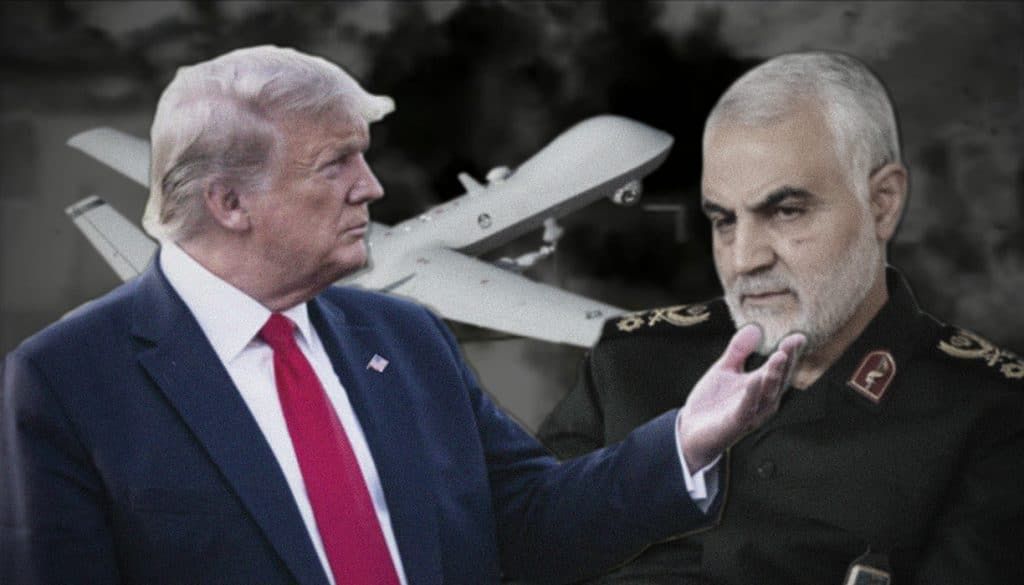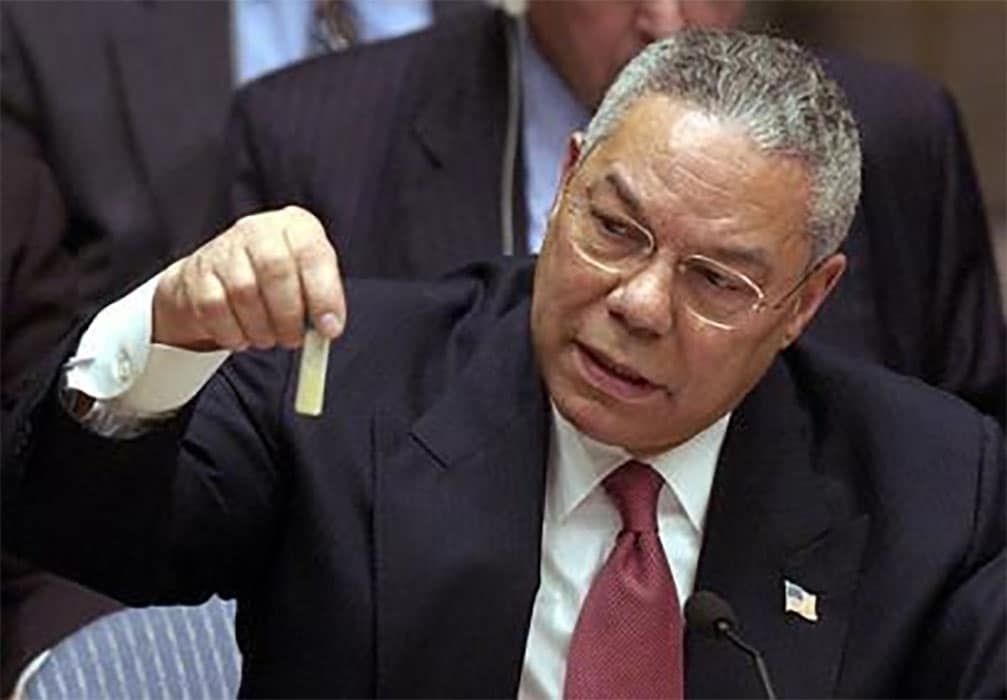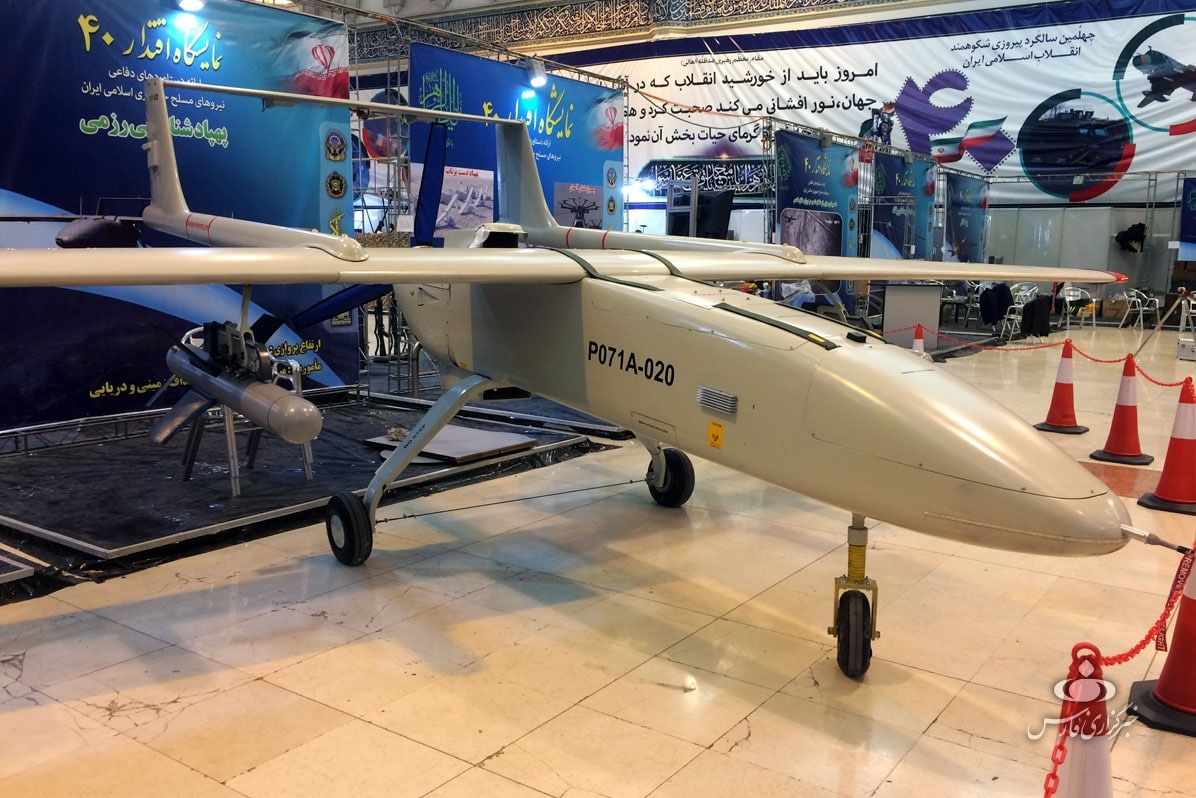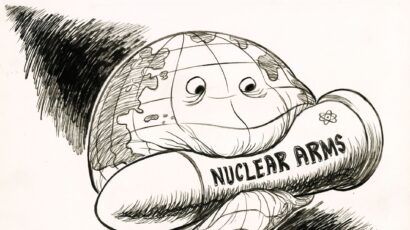The Soleimani killing and 5 things to know about drones in Iraq
By Dan Gettinger | January 7, 2020
 A US drone strike killed Iranian Gen. Qassem Soleimani last week, another chapter in the long story of how drones have been used in conflicts in Iraq. Bulletin Illustration. Soleimani photo courtesy of Khamenei.ir (Creative Commons).
A US drone strike killed Iranian Gen. Qassem Soleimani last week, another chapter in the long story of how drones have been used in conflicts in Iraq. Bulletin Illustration. Soleimani photo courtesy of Khamenei.ir (Creative Commons).
The Iraqi parliament voted to boot US troops from Iraq. Iran announced it would no longer comply with international restrictions on its nuclear program. US President Donald Trump tweeted that the Pentagon would target 52 Iranian sites, including culturally significant ones, if Iran attacked US personnel. And the US secretary of state referred to “this war” with Iran in a television interview.
That was just Sunday’s news.
The event that set off that chain reaction? A likely US drone strike near the Baghdad International Airport late last week that killed top Iranian military leader Maj. Gen. Qassem Soleimani. Although the circumstances are not entirely clear, it appears a US MQ-9 Reaper launched the strike against the general; the attack was the latest chapter in the long story of drone wars in Iraq.
Like neighboring Syria, Iraq today is a hotbed of unmanned aerial activity. Here are five questions (and answers) about military drones in Iraq.
When and how were drones first used in conflicts in Iraq? The saga of drone operations in Iraq is a long one. It likely begins during the Iran-Iraq War in the 1980s, when Iran began developing the Mohajer-1 surveillance drone and flying it over the frontlines. (This story was later turned into a 1990 film.)
During and after the Gulf War, the US military began flying drones over Iraq, marking the first significant US deployment of modern military drones. Iraqi soldiers famously surrendered to a US Navy RQ-2 Pioneer during this conflict.
In the late 1990s, former Iraqi President Saddam Hussein launched Iraq’s drone development program, which the United States later used as part of the justification for the invasion of Iraq in 2003. During the course of the ensuing Iraq War, the United States began deploying drones in ever greater numbers. Systems like the Raven, Shadow, ScanEagle, and Gray Eagle that today form the backbone of the US drone fleet all made their operational debut during this period.

Who operates drones in Iraq today? The Iraqi military has its own fleet of drones, but it’s not clear how many of these aircraft are active. A US military report last year found that most of Iraq’s US-made ScanEagles were left unused due to a lapse in maintenance, and only one of Iraq’s 10 Chinese-made CH-4s remained viable.
In all, eight countries—Iran, Iraq, Israel, Italy, Spain, Turkey, the United States, and the United Kingdom—are believed to have operated drones over Iraq over the past year. The United States, the United Kingdom, Italy, Spain, and Turkey likely fly missions in Iraq on a regular basis, while Israel, Iraq, and Iran have conducted intermittent operations.
In addition to national militaries, a number of armed groups in Iraq have unveiled drones of their own since the rise of Islamic State (ISIS), although it’s not clear whether any of these efforts remain active. ISIS, of course, had a robust drone program in Iraq, relying on a number of Chinese-made off-the-shelf hobbyist drones. Several years ago, Iraqi Shi’ite militias, including the Iranian-backed militia that led protests at the US Embassy last week, displayed Iranian-made systems.
Why are drones flown in Iraq? From Turkish attacks on Kurdish forces to Iran’s support for Iraq’s counter-ISIS fight, drone operations in Iraq reflect the tangled nature of alliances and conflicts in the Middle East. There are three main drivers for why drones are used in Iraq today:
Attacking ISIS. The United States and its allies have deployed drones in support of operations against ISIS. (In the days since Soleimani’s killing, the Pentagon has suspended operations against ISIS in Iraq and Syria.) The United States, the United Kingdom, and Iraq are reported to have carried out drone strikes against ISIS targets, while Italy and Spain have used drones to conduct reconnaissance and to identify targets for Kurdish and other allied forces on the ground. Iran reportedly stood up a small drone unit in Iraq in 2013 or 2014 to support Iraqi counter-ISIS efforts, though it’s unclear how long it remained active.
Attacking Kurdish groups. Turkey and Iran are believed to have launched separate drone operations against Kurdish groups in Iraq. Turkey launched Operation Claw in early 2019 to target Kurdish militant organizations in northern Iraq. According to a Turkish military statement in December, Turkish drone operations in Claw have resulted in the deaths of 174 people. Meanwhile, Iran has reportedly conducted periodic strikes against Kurdish groups along its border in northeastern Iraq. In July, Iran announced that a recently-formed Iranian Revolutionary Guard Corps drone unit had participated in a strike against Iraqi Kurdish groups.
Countering Iran. Israel, and now the United States, have used drones to target Iranian-backed militias in Iraq. In July and August last year Israel reportedly conducted several drone strikes targeting elements of the Popular Mobilization Forces—a coalition of Iraqi paramilitary groups—that are aligned with Iran.

Which drones are flown in Iraq? Look no further than Iraq to get a sense of how drone technology has proliferated in recent years, with a range of countries and firms producing military-grade systems. At least eight different military drones are operated over Iraq. The United States, the United Kingdom, and Italy operate the General Atomics MQ-9 Reaper, the drone that was likely used in the attack on Soleimani. The United States also uses the General Atomics MQ-1C Gray Eagle and, at various points in recent years, the RQ-11 Raven, RQ-20 Puma, RQ-21 Blackjack, and RQ-7 Shadow, as well. Spain flew the Insitu ScanEagle until December, when it was withdrawn and replaced by the Israeli-made Aeronautics Orbiter. Iraq is equipped with the Insitu ScanEagle and Chinese-made CASC CH-4. Turkey operates the Baykar Makina Bayraktar-TB2 and, potentially, the Turkish Aerospace Industries Anka. Iran reportedly deployed a Qods Mohajer-6 in operations against Kurdish militants last year.
Where are the drones based? Several militaries use bases in Iraq, Kuwait, and Turkey to launch drone missions in Iraq. Al Asad Air Base in western Iraq is host to US Air Force MQ-9 Reapers and Army MQ-1C Gray Eagles. The Spanish Army drone unit is also based at Al Asad. In Kuwait, Ali Al Salem Air Base is host to US, UK, and Italian MQ-9 Reaper contingents. Several airports in southwestern Turkey could host the Turkish drones that conduct operations over Iraq. The Turkish military has established drone outposts at Batman Air Base, Şırnak Airport, Van Airport, and Hakkari Yüksekova Airport. In past years, Iraq’s CH-4s have been located at Balad Air Base and Al Kut Air Base.
In certain contexts, military drones offer several technical and tactical advantages over manned aircraft, which is why they are an appealing option for the countries involved in the Iraq conflict. As the Soleimani killing illustrates, though, while the decision to use a drone in an attack may be straightforward, the consequences of doing so are anything but.
Together, we make the world safer.
The Bulletin elevates expert voices above the noise. But as an independent nonprofit organization, our operations depend on the support of readers like you. Help us continue to deliver quality journalism that holds leaders accountable. Your support of our work at any level is important. In return, we promise our coverage will be understandable, influential, vigilant, solution-oriented, and fair-minded. Together we can make a difference.
Keywords: Donald Trump, ISIS, Iran, Israel, MQ-9 Reaper, Qassem Soleimani, Turkey, drones
Topics: Disruptive Technologies















